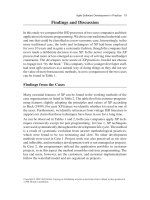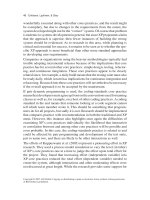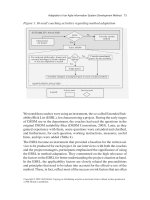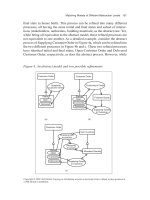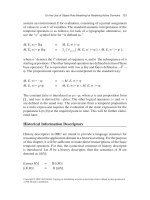140 ebook systems analysis and design (8th edition) part 1
Bạn đang xem bản rút gọn của tài liệu. Xem và tải ngay bản đầy đủ của tài liệu tại đây (7.02 MB, 309 trang )
SYSTEMS ANALYSIS
and DESIGN
This page intentionally left blank
SYSTEMS ANALYSIS
and DESIGN
EIGHTH EDITION
KENNETH E. KENDALL
Rutgers University
School of Business–Camden
Camden, New Jersey
JULIE E. KENDALL
Rutgers University
School of Business–Camden
Camden, New Jersey
Prentice Hall
Boston
Columbus
Upper Saddle River
Milan
Sao Paulo
Munich
Sydney
Indianapolis
Amsterdam
Paris
Cape Town
Montreal
Hong Kong
New York
Dubai
Toronto
Seoul
San Francisco
Delhi
Singapore
London
Madrid
Mexico City
Taipei
Tokyo
To the memory of Julia A. Kendall and the memory of Edward J. Kendall,
whose lifelong example of working together will inspire us forever.
Editorial Director: Sally Yagan
Editor in Chief: Eric Svendsen
Executive Editor: Bob Horan
Editorial Project Manager: Kelly Loftus
Editorial Assistant: Jason Calcano
Director of Marketing: Patrice Lumumba Jones
Senior Marketing Manager: Anne Fahlgren
Senior Managing Editor: Judy Leale
Associate Production Project Manager: Ana Jankowski
Senior Operations Supervisor: Arnold Vila
Senior Art Director: Steve Frim
Text and Cover Designer: Jill Lehan
Cover Art: Richard Kalina, “Carthage” collage,
acrylic, flashe on linen: © 2006
Media Project Manager: Lisa Rinaldi
Media Editor: Denise Vaughn
Full-Service Project Management/Composition: S4Carlisle
Publishing Services, Inc.
Printer/Binder: Courier/Kendallville
Cover Printer: Lehigh-Phoenix Color/Hagerstown
Text Font: 10/12 Times
“Carthage” © 2006 Richard Kalina, used with permission from the artist.
Credits and acknowledgments borrowed from other sources and reproduced, with permission, in this textbook appear on
appropriate page within text.
Microsoft® and Windows® are registered trademarks of the Microsoft Corporation in the U.S.A. and other countries. Screen
shots and icons reprinted with permission from the Microsoft Corporation. This book is not sponsored or endorsed by or
affiliated with the Microsoft Corporation.
Copyright © 2011, 2008, 2005 by Pearson Education, Inc., publishing as Prentice Hall, One Lake Street, Upper Saddle
River, New Jersey 07458. All rights reserved. Manufactured in the United States of America. This publication is protected
by Copyright, and permission should be obtained from the publisher prior to any prohibited reproduction, storage in a
retrieval system, or transmission in any form or by any means, electronic, mechanical, photocopying, recording, or likewise.
To obtain permission(s) to use material from this work, please submit a written request to Pearson Education, Inc.,
Permissions Department, One Lake Street, Upper Saddle River, New Jersey 07458.
Many of the designations by manufacturers and seller to distinguish their products are claimed as trademarks. Where those
designations appear in this book, and the publisher was aware of a trademark claim, the designations have been printed in
initial caps or all caps.
Library of Congress Cataloging-in-Publication Data
Kendall, Kenneth E.
Systems analysis and design / Kenneth E. Kendall, Julie E. Kendall. — 8th ed.
p. cm.
Includes bibliographical references and index.
ISBN-13: 978-0-13-608916-2
ISBN-10: 0-13-608916-X
1. System design. 2. System analysis. 3. Systems programming (Computer science)
I. Kendall, Julie E., II. Title.
QA76.9.S88K45 2010
005.4’2—dc22
2009031275
10 9 8 7 6 5 4 3 2 1
ISBN-10:
0-13-608916-X
ISBN-13: 978-0-13-608916-2
COMPANY
TRADEMARKS
Apple and Macintosh are registered trademarks of Apple Computer. 1Password is a registered
trademark of Agile Web Solutions. Bento is a registered trademark of FileMaker. Dragon
NaturallySpeaking is a registered trademark of Nuance. Dreamweaver, Adobe Flash, and
FormFlow are registered trademarks of Adobe Systems Incorporated. DEVONagent and
DEVONthink Professional Office are registered trademarks of DEVONtechnologies. Firefox is
a trademark of the Mozilla Foundation. Freeway Pro is a registered trademark of Softpress
Systems. HyperCase is a registered trademark of Raymond J. Barnes, Richard L. Baskerville,
Julie E. Kendall, and Kenneth E. Kendall. Microsoft Windows, Microsoft Access, Microsoft
Word, Microsoft PowerPoint, Microsoft Project, Microsoft Excel, and Microsoft Visio are registered trademarks of Microsoft Corporation. OmniFocus is a registered trademark of The Omni
Group. OmniGraffle and OmniPlan are registered trademarks of The Omni Group. OmniPage
is a trademark of Nuance. Palm is a registered trademark of Palm, Inc. ProModel and Service
Model are registered trademarks of ProModel Corporation. Things is a registered trademark of
Cultured Code. VMware Fusion is a registered trademark of VMware. Visible Analyst is a registered trademark of Visible Systems Corporation. WinFax Pro and Norton Internet Security are
registered trademarks of Symantec. Yojimbo is a registered trademark of Bare Bones Software.
Other product and company names mentioned herein may be the trademarks of their respective
owners. Companies, names, and/or data used in screens and sample output are fictitious unless
otherwise noted.
v
BRIEF
CONTENTS
PART I SYSTEMS ANALYSIS FUNDAMENTALS
1 SYSTEMS, ROLES, AND DEVELOPMENT METHODOLOGIES 1
2 UNDERSTANDING AND MODELING ORGANIZATIONAL SYSTEMS 24
3 PROJECT MANAGEMENT 56
PART II INFORMATION REQUIREMENTS ANALYSIS
4 INFORMATION GATHERING: INTERACTIVE METHODS 103
5 INFORMATION GATHERING: UNOBTRUSIVE METHODS 131
6 AGILE MODELING AND PROTOTYPING 155
PART III THE ANALYSIS PROCESS
7
8
9
10
USING DATA FLOW DIAGRAMS 193
ANALYZING SYSTEMS USING DATA DICTIONARIES 228
PROCESS SPECIFICATIONS AND STRUCTURED DECISIONS 259
OBJECT-ORIENTED SYSTEMS ANALYSIS AND DESIGN USING UML 281
PART IV THE ESSENTIALS OF DESIGN
11
12
13
14
DESIGNING EFFECTIVE OUTPUT 329
DESIGNING EFFECTIVE INPUT 371
DESIGNING DATABASES 403
HUMAN-COMPUTER INTERACTION 441
PART V QUALITY ASSURANCE AND IMPLEMENTATION
15 DESIGNING ACCURATE DATA ENTRY PROCEDURES 485
16 QUALITY ASSURANCE AND IMPLEMENTATION 515
GLOSSARY 557
ACRONYMS 565
INDEX 566
vi
CONTENTS
PART I SYSTEMS ANALYSIS FUNDAMENTALS
1
SYSTEMS, ROLES, AND DEVELOPMENT METHODOLOGIES
1
Types of Systems 2
Transaction Processing Systems 2 / Office Automation Systems and Knowledge Work
Systems 2 / Management Information Systems 3 / Decision Support Systems 3 / Artificial
Intelligence and Expert Systems 3 / Group Decision Support Systems and ComputerSupported Collaborative Work Systems 3 / Executive Support Systems 4
Integrating Technologies for Systems 4
Ecommerce Applications and Web Systems 4 / Enterprise Systems 5 / Systems for Wireless
and Mobile Devices 5 / Open Source Software 5
Need for Systems Analysis and Design 6
Roles of the Systems Analyst 6
Systems Analyst as Consultant 6 / Systems Analyst as Supporting Expert 6
Consulting Opportunity 1.1 Healthy Hiring: Ecommerce Help Wanted 7
Systems Analyst as Agent of Change 7 / Qualities of the Systems Analyst 8
The Systems Development Life Cycle 8
Incorporating Human-Computer Interaction Considerations 9 / Identifying Problems,
Opportunities, and Objectives 9 / Determining Human Information Requirements 10 /
Analyzing System Needs 10 / Designing the Recommended System 11 / Developing and
Documenting Software 11 / Testing and Maintaining the System 11 / Implementing and
Evaluating the System 11
MAC APPEAL 12
The Impact of Maintenance 12
Using Case Tools 14
The Agile Approach 14
Developmental Process for an Agile Project 15
Object-Oriented Systems Analysis and Design 17
Choosing Which Systems Development Method to Use 19
SUMMARY 19
HYPERCASE® EXPERIENCE 1 20
KEYWORDS AND PHRASES 21
REVIEW QUESTIONS 21
SELECTED BIBLIOGRAPHY 21
CPU CASE EPISODE 1: The Case Opens 23
vii
viii
CONTENTS
2
UNDERSTANDING AND MODELING ORGANIZATIONAL SYSTEMS
24
Organizations as Systems 24
Interrelatedness and Interdependence of Systems 25
Consulting Opportunity 2.1 The E in Vitamin E Stands for Ecommerce 26
Virtual Organizations and Virtual Teams 26 / Taking a Systems Perspective 27 / Enterprise
Systems: Viewing the Organization as a System 28
Depicting Systems Graphically 29
Systems and the Context-Level Data Flow Diagram 29 / Systems and the EntityRelationship Model 30
MAC APPEAL 35
Use Case Modeling 35
Use Case Symbols 36 / Use Case Relationships 36 / Developing System Scope 38 /
Developing Use Case Diagrams 38 / Developing Use Case Scenarios 38 / Use Case
Levels 39 / Creating Use Case Descriptions 43 / Why Use Case Diagrams Are Helpful 43
Levels of Management 43
Consulting Opportunity 2.2 Where There’s Carbon, There’s a Copy 44
Implications for Information Systems Development 45
Organizational Culture 45
Consulting Opportunity 2.3 Pyramid Power 46
SUMMARY 46
HYPERCASE® EXPERIENCE 2 47
KEYWORDS AND PHRASES 48
REVIEW QUESTIONS 48
PROBLEMS 48
GROUP PROJECTS 49
SELECTED BIBLIOGRAPHY 50
CPU CASE EPISODE 2: Picturing the Relationships 51
3
PROJECT MANAGEMENT
56
Project Initiation 56
Problems in the Organization 57 / Defining the Problem 57
Consulting Opportunity 3.1 The Sweetest Sound I’ve Ever Sipped 58
Selection of Projects 61
Determining Feasibility 62
Determining Whether It Is Possible 62
Ascertaining Hardware and Software Needs 63
Inventorying Computer Hardware 64 / Estimating Workloads 64 / Evaluating Computer
Hardware 65 / Acquisition of Computer Equipment 66 / Software Evaluation 68
Consulting Opportunity 3.2 Veni, Vidi, Vendi, or, I Came, I Saw, I Sold 70
Identifying, Forecasting, and Comparing Costs and Benefits 72
Forecasting 72 / Identifying Benefits and Costs 72
Consulting Opportunity 3.3 We’re Off to See the Wizards 73
Comparing Costs and Benefits 74
Activity Planning and Control 77
Estimating Time Required 77
CONTENTS
Consulting Opportunity 3.4 Food for Thought 78
Using Gantt Charts for Project Scheduling 79 / Using PERT Diagrams 80
Managing the Project 82
Addressing System Complexity 82
MAC APPEAL 83
Managing Analysis and Design Activities 83
Assembling a Team 83
HYPERCASE® EXPERIENCE 3.1 84
Communication Strategies for Managing Teams 84
Consulting Opportunity 3.5 Goal Tending 85
Setting Project Productivity Goals 85 / Motivating Project Team Members 86 / Managing
Ecommerce Projects 86 / Creating the Project Charter 87 / Avoiding Project Failures 87
The Systems Proposal 88
Organizing the Systems Proposal 88 / Using Figures for Effective
Communication 89
SUMMARY 91
HYPERCASE® EXPERIENCE 3.2 92
KEYWORDS AND PHRASES 93
REVIEW QUESTIONS 93
PROBLEMS 94
GROUP PROJECTS 98
SELECTED BIBLIOGRAPHY 98
CPU CASE EPISODE 3: Getting to Know U 100
PART II INFORMATION REQUIREMENTS ANALYSIS
4
INFORMATION GATHERING: INTERACTIVE METHODS
103
Interviewing 103
Five Steps in Interview Preparation 104 / Question Types 105 / Arranging Questions in a
Logical Sequence 107
Consulting Opportunity 4.1 Strengthening Your Question Types 108
Writing the Interview Report 109
Consulting Opportunity 4.2 Skimming the Surface 110
Joint Application Design 111
Conditions That Support the Use of JAD 111 / Who Is Involved? 111
HYPERCASE® EXPERIENCE 4.1 112
Where to Hold JAD Meetings 112
Consulting Opportunity 4.3 A Systems Analyst, I Presume? 113
Accomplishing a Structured Analysis of Project Activities 113 / Potential Benefits of Using
JAD in Place of Traditional Interviewing 113 / Potential Drawbacks of Using JAD 113
Using Questionnaires 114
Planning for the Use of Questionnaires 114 / Writing Questions 115 / Using Scales in
Questionnaires 118 / Designing the Questionnaires 119
Consulting Opportunity 4.4 The Unbearable Questionnaire 120
Consulting Opportunity 4.5 Order in the Courts 121
Administering Questionnaires 122
SUMMARY 122
ix
x
CONTENTS
HYPERCASE® EXPERIENCE 4.2 123
KEYWORDS AND PHRASES 123
REVIEW QUESTIONS 124
PROBLEMS 124
GROUP PROJECTS 127
SELECTED BIBLIOGRAPHY 127
CPU CASE EPISODE 4: I’ll Listen Now, Ask Questions Later 128
5
INFORMATION GATHERING: UNOBTRUSIVE METHODS
131
Sampling 131
The Need for Sampling 132 / Sampling Design 132 / The Sample Size Decision 134
Consulting Opportunity 5.1 Trapping a Sample 135
Investigation 136
Analyzing Quantitative Documents 136
Consulting Opportunity 5.2 A Rose by Any Other Name . . . Or Quality, Not
Quantities 137
Analyzing Qualitative Documents 140
HYPERCASE® EXPERIENCE 5.1 141
Observing a Decision Maker’s Behavior 142
Observing a Typical Manager’s Decision-Making Activities 142
Observing the Physical Environment 142
Structured Observation of the Environment (STROBE) 142
Consulting Opportunity 5.3 Don’t Bank on Their Self-Image or Not Everything
Is Reflected in a Mirror 145
Applying Strobe 146
MAC APPEAL 147
SUMMARY 148
HYPERCASE® EXPERIENCE 5.2 149
KEYWORDS AND PHRASES 150
REVIEW QUESTIONS 150
PROBLEMS 150
GROUP PROJECTS 152
SELECTED BIBLIOGRAPHY 153
CPU CASE EPISODE 5: Seeing Is Believing 154
6
AGILE MODELING AND PROTOTYPING
155
Prototyping 156
Kinds of Prototypes 156 / Prototyping as an Alternative to the SDLC 157
Developing a Prototype 158
Consulting Opportunity 6.1 Is Prototyping King? 159
Guidelines for Developing a Prototype 159
Consulting Opportunity 6.2 Clearing the Way for Customer Links 160
Disadvantages of Prototyping 160
Consulting Opportunity 6.3 To Hatch a Fish 161
Advantages of Prototyping 161 / Prototyping Using COTS Software 161
Consulting Opportunity 6.4 This Prototype Is All Wet 162
Users’ Role in Prototyping 162
CONTENTS
Rapid Application Development 163
Phases of RAD 164 / Comparing RAD to the SDLC 165
Agile Modeling 166
Values and Principles of Agile Modeling 166 / Activities, Resources, and Practices of Agile
Modeling 168 / The Agile Development Process 171
MAC APPEAL 173
Lessons Learned from Agile Modeling 175
Comparing Agile Modeling and Structured Methods 176
Improving Efficiency in Knowledge Work: SDLC Versus Agile 177 / Risks Inherent in
Organizational Innovation 179
SUMMARY 181
HYPERCASE® EXPERIENCE 6 182
KEYWORDS AND PHRASES 183
REVIEW QUESTIONS 183
PROBLEMS 183
GROUP PROJECTS 185
SELECTED BIBLIOGRAPHY 185
CPU CASE EPISODE 6: Reaction Time 186
PART III THE ANALYSIS PROCESS
7
USING DATA FLOW DIAGRAMS
193
The Data Flow Approach to Human Requirements Determination 193
Advantages of the Data Flow Approach 193 / Conventions Used in Data Flow
Diagrams 194
Developing Data Flow Diagrams 195
Creating the Context Diagram 195 / Drawing Diagram 0 (The Next Level) 196 /
Creating Child Diagrams (More Detailed Levels) 198 / Checking the Diagrams
for Errors 198
Logical and Physical Data Flow Diagrams 200
Developing Logical Data Flow Diagrams 202 / Developing Physical Data Flow
Diagrams 203 / Partitioning Data Flow Diagrams 206
A Data Flow Diagram Example 207
Developing the List of Business Activities 207 / Creating a Context-Level Data Flow
Diagram 208 / Drawing Diagram 0 210 / Creating a Child Diagram 211 / Creating a
Physical Data Flow Diagram from the Logical DFD 212 / Partitioning the Physical
DFD 213
Partitioning Web Sites 213
Consulting Opportunity 7.1 There’s No Business Like Flow Business 216
Communicating Using Data Flow Diagrams 217
SUMMARY 217
HYPERCASE® EXPERIENCE 7 218
KEYWORDS AND PHRASES 218
REVIEW QUESTIONS 219
PROBLEMS 219
GROUP PROJECTS 221
SELECTED BIBLIOGRAPHY 221
CPU CASE EPISODE 7: Just Flowing Along 222
xi
xii
CONTENTS
8
ANALYZING SYSTEMS USING DATA DICTIONARIES
228
The Data Dictionary 228
Need for Understanding the Data Dictionary 229
The Data Repository 229
Defining the Data Flows 230 / Describing Data Structures 231 / Logical and Physical Data
Structures 233 / Data Elements 234 / Data Stores 236
Creating the Data Dictionary 238
Analyzing Input and Output 239
Consulting Opportunity 8.1 Want to Make It Big in the Theatre? Improve Your
Diction(ary)! 240
Developing Data Stores 241
Using the Data Dictionary 242
Using Data Dictionaries to Create XML 243 / XML Document Type Definitions 244 /
XML Schemas 246
HYPERCASE® EXPERIENCE 8 247
SUMMARY 248
KEYWORDS AND PHRASES 248
REVIEW QUESTIONS 248
PROBLEMS 249
GROUP PROJECTS 251
SELECTED BIBLIOGRAPHY 251
CPU CASE EPISODE 8: Defining What You Mean 252
9
PROCESS SPECIFICATIONS AND STRUCTURED DECISIONS
259
Overview of Process Specifications 259
Process Specification Format 260
Structured English 261
Writing Structured English 261
Consulting Opportunity 9.1 Kit Chen Kaboodle, Inc. 263
Consulting Opportunity 9.2 Kneading Structure 264
Data Dictionary and Process Specifications 265
Decision Tables 266
Developing Decision Tables 267
Consulting Opportunity 9.3 Saving a Cent on Citron Car Rental 269
Checking for Completeness and Accuracy 270
Decision Trees 271
Consulting Opportunity 9.4 A Tree for Free 272
Drawing Decision Trees 272
Choosing a Structured Decision Analysis Technique 273
SUMMARY 273
HYPERCASE® EXPERIENCE 9 274
KEYWORDS AND PHRASES 274
REVIEW QUESTIONS 274
PROBLEMS 274
GROUP PROJECTS 276
SELECTED BIBLIOGRAPHY 276
CPU CASE EPISODE 9: Tabling a Decision 277
CONTENTS
10 OBJECT-ORIENTED SYSTEMS ANALYSIS AND DESIGN USING UML
281
Object-Oriented Concepts 282
Objects 282 / Classes 282 / Inheritance 283
Consulting Opportunity 10.1 Around the World in 80 Objects 284
CRC Cards and Object Think 284
Interacting During a CRC Session 284
The Unified Modeling Language (UML) Concepts and Diagrams 286
Use Case Modeling 287
Activity Diagrams 290
Creating Activity Diagrams 292
Consulting Opportunity 10.2 Recycling the Programming Environment 293
Repository Entries for an Activity Diagram 294
Sequence and Communication Diagrams 294
Sequence Diagrams 294 / Communication Diagrams 296
Class Diagrams 297
Method Overloading 298 / Types of Classes 299 / Defining Messages and Methods 300
Enhancing Sequence Diagrams 300
A Class Example for the Web 300 / Presentation, Business, and Persistence Layers in
Sequence Diagrams 302
Enhancing Class Diagrams 303
Relationships 304 / Generalization/Specialization (Gen/Spec) Diagrams 306
Statechart Diagrams 309
A State Transition Example 310
Packages and Other UML Artifacts 311
Consulting Opportunity 10.3 Developing a Fine System That Was Long Overdue:
Using Object-Oriented Analysis for the Ruminski Public Library System 313
Putting UML to Work 313
Consulting Opportunity 10.4 C-Shore؉؉ 315
The Importance of Using UML for Modeling 315
SUMMARY 316
HYPERCASE® EXPERIENCE 10 317
KEYWORDS AND PHRASES 317
REVIEW QUESTIONS 318
PROBLEMS 318
SELECTED BIBLIOGRAPHY 319
CPU CASE EPISODE 10: Classy Objects 320
PART IV THE ESSENTIALS OF DESIGN
11 DESIGNING EFFECTIVE OUTPUT
329
Output Design Objectives 329
Designing Output to Serve the Intended Purpose 329 / Designing Output to Fit the
User 330 / Delivering the Appropriate Quantity of Output 330 / Making Sure the Output Is
Where It Is Needed 330 / Providing the Output on Time 330 / Choosing the Right Output
Method 330
xiii
xiv
CONTENTS
Relating Output Content to Output Method 330
Output Technologies 331
Consulting Opportunity 11.1 Your Cage or Mine? 335
Factors to Consider When Choosing Output Technology 336
Consulting Opportunity 11.2 A Right Way, a Wrong Way, and a Subway 339
Realizing How Output Bias Affects Users 340
Recognizing Bias in the Way Output Is Used 340 / Avoiding Bias in the
Design of Output 341 / Designing Printed Output 341 / Guidelines for
Printed Report Design 341
Consulting Opportunity 11.3 Should This Chart Be Barred? 342
Designing Output for Displays 344
Guidelines for Display Design 344 / Using Graphical Output in Screen Design 345 /
Dashboards 346 / Widgets and Gadgets—Changing the Desktop Metaphor 347
Consulting Opportunity 11.4 Is Your Work a Grind? 348
Designing a Web Site 348
General Guidelines for Designing Web Sites 348
MAC APPEAL 351
Consulting Opportunity 11.5 A Field Day 356
Maintaining Web Sites 356 / Creating Blogs (Web Logs) 357
Output Production and XML 357
Ajax 358
HYPERCASE® EXPERIENCE 11 360
SUMMARY 360
KEYWORDS AND PHRASES 361
REVIEW QUESTIONS 361
PROBLEMS 362
GROUP PROJECTS 365
SELECTED BIBLIOGRAPHY 365
CPU CASE EPISODE 11: Reporting on Outputs 366
12 DESIGNING EFFECTIVE INPUT
371
Good Form Design 371
Making Forms Easy to Fill In 372 / Meeting the Intended Purpose 374 / Ensuring Accurate
Completion 375 / Keeping Forms Attractive 375 / Controlling Business Forms 376
Good Display and Web Forms Design 376
Keeping the Display Simple 376
Consulting Opportunity 12.1 This Form May Be Hazardous to Your Health 377
Keeping the Display Consistent 378 / Facilitating Movement 378 / Designing an Attractive
and Pleasing Display 378 / Using Icons in Display Design 378
Consulting Opportunity 12.2 Squeezin’ Isn’t Pleasin’ 379
Graphical User Interface Design 379 / Form Controls and Values 381 / Hidden Fields 382 /
Event-Response Charts 382 / Dynamic Web Pages 383 / Three-Dimensional Web Pages
385 / Ajax (Asynchronous JavaScript and XML) 387 / Using Color in Display Design 389
Intranet and Internet Page Design 389
Consulting Opportunity 12.3 It’s Only Skin Deep 390
MAC APPEAL 392
CONTENTS
SUMMARY 392
HYPERCASE® EXPERIENCE 12 393
KEYWORDS AND PHRASES 394
REVIEW QUESTIONS 394
PROBLEMS 395
GROUP PROJECTS 397
SELECTED BIBLIOGRAPHY 398
CPU CASE EPISODE 12: Forming Screens and Screening Forms 399
13 DESIGNING DATABASES 403
Databases 403
Consulting Opportunity 13.1 Hitch Your Cleaning Cart to a Star 404
Data Concepts 404
Reality, Data, and Metadata 404 / Files 410 / Relational Databases 411
Normalization 413
The Three Steps of Normalization 413 / A Normalization Example 414 / Using the EntityRelationship Diagram to Determine Record Keys 421 / One-to-Many Relationship 422 /
Many-to-Many Relationship 423
Guidelines for Master File/Database Relation Design 424
Integrity Constraints 424
MAC APPEAL 425
Anomalies 425
Making Use of the Database 426
Steps in Retrieving and Presenting Data 426
Denormalization 426
Data Warehouses 429
Online Analytic Processing 429 / Data Mining 429
Consulting Opportunity 13.2 Storing Minerals for Health, Data for Mining 430
Consulting Opportunity 13.3 Losing Prospects 431
SUMMARY 432
HYPERCASE® EXPERIENCE 13 433
KEYWORDS AND PHRASES 433
REVIEW QUESTIONS 434
PROBLEMS 434
GROUP PROJECT 436
SELECTED BIBLIOGRAPHY 436
CPU CASE EPISODE 13: Back to Data Basics 437
14 HUMAN-COMPUTER INTERACTION
441
Understanding Human-Computer Interaction 441
How Fit Affects Performance and Well-Being 442 / The Technology Acceptance Model
and Attitude 443
Usability 444
Designing for the Cognitive Styles of Individual Users 444 / Physical Considerations in
HCI Design 448 / Considering Human Limitations, Disabilities, and Design 449
Consulting Opportunity 14.1 School Spirit Comes in Many Sizes 450
Implementing Good HCI Practices 450
xv
xvi
CONTENTS
Types of User Interface 451
Natural-Language Interfaces 451 / Question-and-Answer Interfaces 452 / Menus 453
Consulting Opportunity 14.2 I’d Rather Do It Myself 454
Form-Fill Interfaces (Input/Output Forms) 454 / Command-Language Interfaces 455
Consulting Opportunity 14.3 Don’t Slow Me Down 456
Graphical User Interfaces 456
Consulting Opportunity 14.4 That’s Not a Lightbulb 457
Other User Interfaces 457
Guidelines for Dialog Design 458
Meaningful Communication 459 / Minimal User Action 459
Consulting Opportunity 14.5 Waiting to Be Fed 461
Standard Operation and Consistency 461
Feedback for Users 461
Types of Feedback 462 / Including Feedback in Design 464
Special Design Considerations for Ecommerce 465
Soliciting Feedback from Ecommerce Web Site Customers 465 / Easy Navigation for
Ecommerce Web Sites 465
Consulting Opportunity 14.6 When You Run a Marathon,It Helps to Know Where
You’re Going 466
MAC APPEAL 467
Mashups 468
Designing Queries 468
Query Types 469 / Query Methods 471
Consulting Opportunity 14.7 Hey, Look Me Over (Reprise) 472
SUMMARY 474
KEYWORDS AND PHRASES 474
HYPERCASE® EXPERIENCE 14 475
REVIEW QUESTIONS 476
PROBLEMS 476
GROUP PROJECTS 477
SELECTED BIBLIOGRAPHY 478
CPU CASE EPISODE 14: Up to the Users 479
PART V QUALITY ASSURANCE AND IMPLEMENTATION
15 DESIGNING ACCURATE DATA ENTRY PROCEDURES
485
Effective Coding 485
Keeping Track of Something 486 / Classifying Information 487 / Concealing Information
488 / Revealing Information 488 / Unicode 490 / Requesting Appropriate Action 491 /
General Guidelines for Coding 491
Consulting Opportunity 15.1 It’s a Wilderness in Here 492
Consulting Opportunity 15.2 Catching a Summer Code 494
Effective and Efficient Data Capture 494
Deciding What to Capture 494 / Letting the Computer Do the Rest 495 / Avoiding
Bottlenecks and Extra Steps 496 / Starting with a Good Form 496 / Choosing a Data Entry
Method 496
CONTENTS
Consulting Opportunity 15.3 To Enter or Not to Enter: That Is the Question 499
Ensuring Data Quality Through Input Validation 499
Validating Input Transactions 500 / Validating Input Data 500
Consulting Opportunity 15.4 Do You Validate Parking? 504
The Process of Validation 505
Accuracy Advantages in Ecommerce Environments 506
Customers Keying Their Own Data 506 / Storing Data for Later Use 506 / Using Data
Through the Order Fulfillment Process 506 / Providing Feedback to Customers 506
HYPERCASE® EXPERIENCE 15 507
SUMMARY 507
KEYWORDS AND PHRASES 508
REVIEW QUESTIONS 508
PROBLEMS 509
GROUP PROJECTS 511
SELECTED BIBLIOGRAPHY 511
CPU CASE EPISODE 15: Entering Naturally 512
16 QUALITY ASSURANCE AND IMPLEMENTATION
515
The Total Quality Management Approach 516
Six Sigma 516 / Responsibility for Total Quality Management 516 / Structured
Walkthrough 517
Consulting Opportunity 16.1 The Quality of MIS Is Not Strained 518
Top-Down Systems Design and Development 518
MAC APPEAL 520
Using Structure Charts to Design Modular Systems 520 / Service-Oriented Architecture
(SOA) 522
Documentation Approaches 523
Procedure Manuals 523 / The FOLKLORE Method 523
Consulting Opportunity 16.2 Write Is Right 524
HYPERCASE® EXPERIENCE 16.1 525
Choosing a Design and Documentation Technique 526
Testing, Maintenance, and Auditing 526
The Testing Process 526
Consulting Opportunity 16.3 Cramming for Your Systems Test 528
Maintenance Practices 528 / Auditing 529
Implementing Distributed Systems 529
Client-Server Technology 529 / Cloud Computing 531 / Network Modeling 533
Training Users 536
Training Strategies 537 / Guidelines for Training 537
Consulting Opportunity 16.4 You Can Lead a Fish to Water . . . But You Can’t Make
It Drink 538
Conversion to a New System 539
Conversion Strategies 539 / Other Conversion Considerations 540 / Organizational
Metaphors and Their Relationship to Successful Systems 541
Security Concerns for Traditional and Web-Based Systems 542
Physical Security 542 / Logical Security 542 / Behavioral Security 543 / Special Security
Considerations for Ecommerce 543 / Privacy Considerations for Ecommerce 544 / Disaster
Recovery Planning 544
xvii
xviii
CONTENTS
Consulting Opportunity 16.5 The Sweet Smell of Success 546
Evaluation 546
Evaluation Techniques 546 / The Information System Utility Approach 546
Consulting Opportunity 16.6 Mopping Up with the New System 548
Evaluating Corporate Web Sites 548
SUMMARY 550
HYPERCASE® EXPERIENCE 16.2 551
KEYWORDS AND PHRASES 551
REVIEW QUESTIONS 551
PROBLEMS 552
GROUP PROJECTS 554
SELECTED BIBLIOGRAPHY 554
CPU CASE EPISODE 16: Semper Redundate 555
GLOSSARY 557
ACRONYMS 565
INDEX 566
PREFACE
NEW TO THIS EDITION
The eighth edition of Kendall & Kendall: Systems Analysis and Design includes substantial
changes mandated by the rapid changes in the IS field in the last three years, and they are included
as a response to the input of our adopters, students, and reviewers. Many new and updated features are integrated throughout. In particular:
᭹
᭹
᭹
᭹
᭹
᭹
᭹
᭹
᭹
᭹
᭹
᭹
᭹
Early introduction of three methodologies: SDLC, agile approaches, and object-oriented
systems analysis and design with UML, along with reasons and situations for when to
use them (Chapter 1)
Expanded coverage of COTS due to their increasing use in organizations (Chapter 3)
Object-oriented analysis and design expanded and featured in the center of the text so it
can be more easily incorporated into term projects (Chapter 10)
New object-oriented analysis and design problems included in the O-O CPU Episode
(Chapter 10)
New feature throughout the text called Mac Appeal, which discusses innovative software available on Macs
New coverage of cloud computing (Chapter 16)
New section on SOA (service-oriented architecture) (Chapter 16)
New end-of-chapter Review Questions, Problems, and Group Exercises
Reorganized, updated, and strengthened chapter on agile methods (Chapter 6)
Strengthened project management by introducing the project charter early in the process
(Chapter 3)
Early introduction of how to prepare the systems proposal (Chapter 3)
Updated and streamlined CPU Case Episodes, the case that runs throughout the text.
Students can use Microsoft Access, Microsoft Visio, or Visible Analyst to complete new
assignments throughout the text
Updated scenarios, problems, and graphics throughout the text to accompany
HyperCase 2.8, a graphical simulation for the Web that allows students to apply their
new skills
DESIGN FEATURES
Figures take on a stylized look in order to help students
more easily grasp the subject matter.
Conceptual diagrams are used to introduce the many
tools that systems analysts have at their disposal. This example shows the differences between logical data flow diagrams and physical data flow diagrams. Conceptual
diagrams are color coded so that students can distinguish
easily among them, and their functions are clearly indicated.
Many other important tools are illustrated, including use
case diagrams, sequence diagrams, and class diagrams.
Logical Data Flow Diagram
D1
Customer
Prices
Customer
Prices
Items to
Purchase
Payment
Receipt
2
1
Item ID
Identify
Item
4
3
Look Up
Prices
Compute
Total
Cost of
Order
Items and Prices
Amount to Be Paid
Settle
Transaction
and Issue
Receipt
Physical Data Flow Diagram
D1
Customer
Items Brought
to Checkout
1
Pass
Items Over
Scanner
(Manual)
UPC Price File
UPC Code
D2
Item Description
and Prices
Look Up
Code and
Price
in File
Customer
Items, Prices,
and Subtotals
Cash, Check,
or Debit Card
3
2
UPC Bar Code
Temporary
Trans. File
Items and
Prices
Item Codes and Prices
Compute
Total
Cost
Cash Register
Receipt
4
Calculated
Amount to Be Paid
Collect Money
and Give
Receipt
(Manual)
xix
xx
PREFACE
Computer displays demonstrate important software
features that are useful to the analyst. This example
shows how a Web site can be evaluated for broken links
by using a package such as Microsoft Visio. Actual screen
shots show important aspects of design. Analysts are continuously seeking to improve the appearance of the
screens and Web pages they design. Colorful examples
help to illustrate why some screen designs are particularly effective.
Paper forms are used throughout to show input and
output design as well as the design of questionnaires.
Blue ink is always used to show writing or data input,
thereby making it easier to identify what was filled in by
users. Although most organizations have computerization of manual processes as their eventual goal, much
data capture is still done using paper forms. Improved
form design enables analysts to ensure accurate and complete input and output. Better forms can also help streamline new internal workflows that result from newly automated business-to-consumer (B2C) applications for
ecommerce on the Web.
Tables are used when an important list needs special
attention, or when information needs to be organized or
classified. In addition, tables are used to supplement the
understanding of the reader in a way that departs from
how material is organized in the narrative portion of the text. Most analysts find tables a useful
way to organize numbers and text into a meaningful “snapshot.”
This example of a table from Chapter 3 shows how analysts can refine their activity plans for
analysis by breaking them down into smaller tasks and then estimating how much time it will take
to complete them. The underlying philosophy of our book
is that systems analysis and design is a process that integrates the use of many tools with the unique talents of the
systems analyst to systematically improve business
through the implementation or modification of computerized information systems. Systems analysts can grow in
their work by taking on new IT challenges and keeping
current in their profession through the application of new
techniques and tools.
Check
PROJ. NAME
OAK. FC
for erro
#
Look fo
r
opport
un
for impr ities
in desig ovement
n.
rs.
562
RENT POTENTIAL
KEY SIGNATUR
1175/0 81299
E
DEPOSIT
Base Refrig
POTENTIAL
Rent erator - Furni- A/C Util.
ture
HMSR T.V.
Maid Total Secur855
PRORATE
Clean55
Rent ity
31175/0 81299 31700
ing
910
Days
Daily
Tax
H/S
H/S
dep. rent
Rate
PAYMENT
RECORD: Tot.
31175
Memo Only
TV 10/3 MO!
C1H/S9-16
Bill 1 MO
Prorated
H/S should be
created towa
rd
refund deposit
Orig. Move-in
BLDG. #
Date
/0 + 81299 +
200 115
Rent
4
30.33
1.30
15.00
121.32
Totals
5. 20
910
= 910
39
Date Date
Deposits 31.63
Receipt Paid
Due Paid Numb
TOTAL INITIAL
to
340
PAYMENT REQU
er Noon Total Secur- Clean- 31700
8/28 8
Rent ity
IRED: 1430.52
/28 106642 9
ing
Tax 31175/0 81299
Other Amou
/30
10/1 10
Dates Amt. Descr
/3 107503 10 1031.32 202 115 44.20
. Amt. Paid nt Balance
/31 910
11/1 11
25
Due
/1 10935 11
82
414.
15 1430.52
/16 485.28
11/17 11
0
/8 11200 11
/23 212.31
11/24
910
0
485.28
0
212.31
0
8-28
Observe the
type
number and
ions.
of transact
d
same
Exp.
NAME
x#
Kendall
1
1st
Watch for places
the computer can
simplify the work.
Detailed Activity
Data gathering
Conduct interviews
Administer questionnaires
Read company reports
Introduce prototype
Observe reactions to prototype
3
4
4
5
3
Data flow and decision analysis
Analyze data flow
8
Proposal preparation
Perform cost-benefit analysis
Prepare proposal
Present proposal
3
2
2
Break
these
down
furthe
r,
A BRIEF TOUR OF THE EIGHTH EDITION
Part I:
Systems Analysis
Fundamentals
Part V:
Quality
Assurance and
Implementation
Part IV:
The Essentials
of Design
Weeks
Required
Activity
Part II:
Information
Requirements
Analysis
Part III:
The Analysis
Process
e
timat
then es ired.
qu
time re
PREFACE
Systems analysis and design is typically taught in one or two semesters. Our book may be used
in either situation. The text is appropriate for undergraduate (junior or senior) curricula at a fouryear university, graduate school, or community college. The level and length of the course can be
varied and supplemented by using real-world projects, HyperCase, or other materials available
on the Instructor Resource Center.
The text is divided into five major parts: Systems Analysis Fundamentals (Part I),
Information Requirements Analysis (Part II), The Analysis Process (Part III), The Essentials of
Design (Part IV), and Quality Assurance and Implementation (Part V).
Part I (Chapters 1–3) stresses the basics that students need to know about what an analyst
does and introduces the three main methodologies of the systems development life cycle
(SDLC), agile approaches, and object-oriented analysis
with UML, along with reasons and situations for when to
use them. Part I shows how a variety of emerging information systems, including mobile and wireless technologies, and enterprise systems integrate IT and fit into organizations; how to determine whether a systems project
is worthy of commitment; ecommerce project management; and how to manage a systems project using special
software tools. The three roles of the systems analyst as
consultant, supporting expert, and agent of change are introduced, and ethical issues and professional guidelines
for serving as a systems consultant are covered. There is
also material on virtual teams and virtual organizations,
and the concept of HCI is introduced. The use of open source software (OSS) is also introduced.
Chapter 2 includes how to initially approach an organization by drawing context-level data flow
diagrams, using entity-relationship models, and developing use cases and use case scenarios.
Chapter 3 introduces expanded material on creating the project charter and introduces writing
the systems proposal early in the process, no matter what method of analysis and design has been
chosen. Expanded coverage of evaluating software and hardware, and when to use COTS (commercial off-the-shelf software), is included. This chapter teaches several methods for forecasting costs and benefits, which are necessary to the discussion of acquiring software and hardware.
Chapter 3 helps students evaluate software by assessing trade-offs among creating custom software, purchasing commercial-off-the-shelf (COTS) software, or outsourcing to an application
service provider (ASP). Creating a problem definition and determining feasibility are also covered. Chapter 3 guides students in professionally writing and presenting an effective systems
proposal, one that incorporates figures and graphs to communicate with users.
Part II (Chapters 4–6) emphasizes the use of systematic and structured methodologies for
performing information requirements analysis. Attention to analysis helps analysts ensure that
they are addressing the correct problem before designing
the system. Chapter 4 introduces a group of interactive
methods, including interviewing, joint application design
(JAD), and constructing questionnaires. Chapter 5 introduces a group of unobtrusive methods for ascertaining information requirements of users. These methods include
sampling, investigating hard and archival data, and observation of decision makers’ behavior and their physical
environment. Chapter 6 on agile modeling and prototyping is innovative in its treatment of prototyping as another
data-gathering technique that enables the analyst to solve
the right problem by getting users involved from the start.
Agile approaches have their roots in prototyping, so this
chapter begins with prototyping to provide a proper context for understanding, and then takes up
the agile approach. The values and principles, activities, resources, practices, processes, and tools
associated with agile methodologies are presented. This chapter also includes material on rapid
application development (RAD) for human information-requirements gathering and interface
design.
Begin Object-Oriented
Analysis and Design
Develop and
Document the
System
Draw Use Case
Diagrams
Systems Design
Phase
Problem Identification
Phase
Modify Diagrams and
Complete
Specifications
Write Use Case
Scenarios
Derive Activity
Diagrams from Use
Cases
Draw Statechart
Diagrams
Systems Analysis
Phase
Create Class
Diagrams
Develop Sequence
Diagrams
Prototype Evaluation
Form
Michael Cerveris
Observer Name
System or Projec
t Name
Date
1/06/2010
Cloud Computing
Company or Locati
Data Center
on
Program Name or
Aquarius Water
Number
Filters
Prev. Maint.
Version
User 1
User Name
User 2
Andy H.
User 3
Pam H.
Period Observed
1/06/2010
1/06/2010
User Reactions
Generally
Excellent!
favorable,
got excited
about project
User Suggestions
Add the date
Place a form
when maintenanc
e number on top
was performed.
for reference.
Place word
WEEKLY in title.
Innovations
Revision Plans
Modify on
1/08/2010
Review with
Andy and Pam.
1
User 4
xxi
xxii
PREFACE
Part III (Chapters 7–10) details the analysis
::Class
Object::Class
process. It builds on the previous two parts to move students into analysis of data flows as well as structured and
semistructured decisions. It provides step-by-step details
method(Parameter)
on how to use structured techniques to draw data flow direturn
agrams (DFDs). Chapter 7 provides coverage of how to
create child diagrams; how to develop both logical and
physical data flow diagrams; and how to partition data
flow diagrams. Chapter 8 features material on the data
repository and vertical balancing of data flow diagrams.
Chapter 8 also includes extensive coverage of extensible
asynchronousSignal( )
markup language (XML) and demonstrates how to use
data dictionaries to create XML. Chapter 9 includes material on developing process specifications. A discussion
of both logical and physical process specifications shows
how to use process specifications for horizontal balancing. Chapter 9 also covers how to diagram structured decisions with the use of structured English, decision tables, and decision trees. In addition, the chapter covers how to choose an appropriate decision
analysis method for analyzing structured decisions and creating process specifications. Push technologies are also introduced.
Part III concludes with Chapter 10 on object-oriented systems analysis and design. This chapter includes an in-depth section on using unified modeling language (UML). There is detailed coverage of the use case model, creating the class model diagram with UML, sequence diagrams, creating gen/spec diagrams, use case scenarios, and activity diagrams. Through several examples and
Consulting Opportunities, this chapter demonstrates how to use an object-oriented approach.
Consulting Opportunities, diagrams, and problems enable students to learn and use UML to model
systems from an object-oriented perspective. Students learn the appropriate situations for using an
object-oriented approach. This chapter helps students to decide whether to use the SDLC, the agile
approach, or object-oriented systems analysis and design to develop a system.
Part IV (Chapters 11–14) covers the essentials of
design. It begins with designing output, because many
practitioners believe systems to be output driven. The design of Web-based forms is covered in detail. Particular
attention is paid to relating output method to content, the
effect of output on users, and designing good forms and
screens. Chapter 11 compares advantages and disadvantages of output, including Web displays, audio, DVD, and
electronic output such as email and RSS feeds. Designing
a Web site for ecommerce purposes is emphasized, and output production and XML is covered.
Chapter 12 includes innovative material on designing Web-based input forms, as well as other
electronic forms design. Also included is computer-assisted forms design.
Chapter 12 features in-depth coverage of Web site design, including guidelines on when designers should add video, audio, and animation to Web site designs. The chapter also covers uses
of Web push and pull technologies for output designs. There is detailed consideration of how to
create effective graphics for corporate Web sites and ways to design effective onscreen navigation for Web site users.
Coverage of intranet and extranet page design is also included. Consideration of database integrity constraints has been included as well, in addition to how the user interacts with the computer and how to design an appropriate interface. The importance of user feedback is also found
in Part IV. How to design accurate data entry procedures that take full advantage of computer and
human capabilities to assure entry of quality data is emphasized here.
Chapter 13 demonstrates how to use the entity-relationship diagram to determine record
keys, as well as providing guidelines for file/database relation design. Students are shown the relevance of database design for the overall usefulness of the system, and how users actually use
databases.
jpeg image
Web site logo
Feature story
Banner ads
Search engine
Links to
sub-Webs
RSS feeds
Video
subscription
Advertisements
Quick links
Main
stories
Chat rooms
Email contact link
PREFACE
Chapter 14 emphasizes Human–Computer Interaction (HCI), especially as it relates to interface design. It introduces HCI, discussing its importance in designing systems that suit individuals and assisting them in achieving personal and organizational goals through their use of information technology. The concepts of usability, fit, perceived usefulness, and perceived ease of use
are introduced, as is the Technology Acceptance Model (TAM), so that systems students can
knowledgeably incorporate HCI practices into their designs. Chapter 14 also features material on
designing easy onscreen navigation for Web site visitors. The chapter presents innovative approaches to searching on the Web, highlights material on GUI design, and provides innovative
approaches to designing dialogs. Chapter 14 articulates specialized design considerations for
ecommerce Web sites. Mashups, new applications created by combining two or more Web-based
application programming interfaces, are also introduced. Chapter 14 also includes extensive
coverage on how to formulate queries, all within the framework of HCI.
Part V (Chapters 15 and 16) concludes the book.
Chapter 15 focuses on designing accurate data entry procedures and includes material on managing the supply
chain through the effective design of business-to-business (B2B) ecommerce. Chapter 16 emphasizes taking a
total quality approach to improving software design and
maintenance. In addition, material on system security
and firewalls is included. Testing, auditing, and maintenance of systems are discussed in the context of total
quality management. This chapter helps students understand how service-oriented architecture (SOA) and cloud
computing are changing the nature of information systems design. In addition, students learn how to design appropriate training programs for users of the new system,
how to recognize the differences among physical conversion strategies, and how to be able to recommend an appropriate one to a client. Chapter 16 also presents techniques for modeling networks, which can
be done with popular tools such as Microsoft Visio.
Material on security and privacy in relation to designing ecommerce applications is included.
Coverage of security, specifically firewalls, gateways, public key infrastructure (PKI), secure
electronic translation (SET), secure socket layering (SSL), virus protection software, URL filtering products, email filtering products, and virtual private networks (VPN), is included.
Additionally, current topics of interest to designers of ecommerce applications, including the
development and posting of corporate privacy policies, are covered.
Important coverage of how the analyst can promote and then monitor a corporate Web site is
included in this section, which features Web activity monitoring, Web site promotion, Web traffic analysis, and audience profiling to ensure the effectiveness of new ecommerce systems.
Techniques for evaluating the completed information systems project are covered systematically
as well.
The eighth edition contains an updated Glossary of terms and a separate list of updated
Acronyms used in the book and in the systems analysis and design field.
Web Services
Database Services
Application Services
Client Computers
PEDAGOGICAL FEATURES
Chapters in the eighth edition contain:
᭹
᭹
᭹
᭹
᭹
᭹
᭹
Learning Objectives at the beginning of each chapter
Summaries that tie together the salient points of each chapter while providing an excellent source of review for exams
Keywords and Phrases
Review Questions
Problems
Group Projects that help students work together in a systems team to solve important
problems that are best solved through group interaction
Consulting Opportunities—now more than 60 minicases throughout the book
xxiii
xxiv
PREFACE
᭹
᭹
᭹
Mac Appeal columns that update students on design software available on the Mac and
iPhone
HyperCase Experiences
CPU Case Episodes—parts of an ongoing case threaded throughout the book
CONSULTING OPPORTUNITIES
The eighth edition presents more than 60 Consulting
Opportunities, and many of them address relevant and
emerging topics that have arisen in the field, including designing systems from an HCI perspective, ecommerce applications for the Web, COTS software, and using UML
to model information systems from an object-oriented
perspective. Consulting Opportunities can be used for
stimulating in-class discussions, or assigned as homework or take-home exam questions.
Because not all systems are extended two- or threeyear projects, our book contains many Consulting Opportunities that can be solved quickly in 20
to 30 minutes of group discussion or individual writing. These minicases, written in a humorous
manner to enliven the material, require students to synthesize what they have learned up to that
point in the course, ask students to mature in their professional and ethical judgment, and expect
students to articulate the reasoning that led to their systems decisions.
AUDIOLOGICAL EXAMINATION REPORT
Patient Last Name
Examining Station
Patient Number
First Exam
500
500
1000
First
Date of Exam
Social Security Number
Middle Initial
Claim number
Right ear
2000 4000
Right ear
1000 2000 4000
AIR CONDUCTION
6000
500
BONE CONDUCTION
6000
500
Left ear
2000 4000
6000
Left ear
1000 2000 4000
6000
1000
SPEECH AUDIOMETRY SECT.
Comments [
SPEECH RECEP. THRESHOLD
Right Ear [ ]
Left Ear [ ]
Referred by [
RIGHT EAR DISCR.
Reason for referral
% [ ] Masking [ ]
Examining Audiologist
LEFT EAR DISCRIM. Exam. Audiologist’s No.
% [ ] Masking [ ]
Next Appt.
]
HYPERCASE EXPERIENCES
HyperCase® Experiences that pose challenging student exHYPERCASE
EXPERIENCE 3.2
ercises are present in each chapter. New scenarios, graphics, and problems to accompany HyperCase version 2.8
“S
are included in the eighth edition. HyperCase has organizational problems featuring state-of-the-art technological
systems. HyperCase represents an original virtual organization that allows students who access it to become immediately immersed in organizational life. Students will interview people, observe office environments, analyze their
prototypes, and review the documentation of their existing
systems. HyperCase 2.8 is Web-based, interactive software that presents an organization called Maple Ridge
Engineering (MRE) in a colorful, three-dimensional
graphics environment. HyperCase permits professors to
begin approaching the systems analysis and design class with exciting multimedia material.
Carefully watching their use of time and managing multiple methods, students use the hypertext
characteristics of HyperCase on the Web to create their own individual paths through the
organization.
Maple Ridge Engineering is drawn from the actual consulting experiences of the authors of
the original version (Raymond Barnes, Richard Baskerville, Julie E. Kendall, and Kenneth E.
Kendall). Allen Schmidt joined the project for version 2.0 and has remained with it. Peter Schmidt
was the HTML programmer, and Jason Reed created the images for the initial Web version.
In each chapter, there are newly updated HyperCase Experiences that include assignments
(and even some clues) to help students solve the difficult organizational problems including developing new systems, merging departments, hiring of employees, security, ecommerce, and disaster recovery planning they encounter at MRE. HyperCase has been fully tested in classrooms,
and was an award winner in the Decision Sciences Institute Innovative Instruction competition.
®
ometimes the people who have been here for some time are
surprised at how much we have actually grown. Yes, I do admit that
it isn’t easy to keep track of what each person is up to or even what
purchases each department has made in the way of hardware and
software. We’re working on it, though. Snowden would like to see
more accountability for computer purchases. He wants to make sure
we know what we have, where it is, why we have it, who’s using it,
and if it’s boosting MRE productivity, or, as he so delicately puts it,
‘to see whether it’s just an expensive toy’ that we can live without.”
HYPERCASE Questions
1. Complete a computer equipment inventory for the Training
and Management Systems Unit, describing all the systems
you find. Hint: Create an inventory form to simplify your
task.
2. Using the software evaluation guidelines given in the text, do
a brief evaluation of GEMS, a software package used by the
Management Systems employees. In a paragraph, briefly
critique this custom software by comparing it with
commercial off-the-shelf software such as Microsoft Project.
3. List the intangible costs and benefits of GEMS as reported by
employees of MRE.
4. Briefly describe the two alternatives Snowden is considering
for the proposed project tracking and reporting system.
5. What organizational and political factors should Snowden
consider in proposing his new system at MRE? (In a brief
paragraph, discuss three central conflicts.)
FIGURE 3.HC1
The reception room resembles a typical corporation. While you are in this HyperCase
screen, find the directory if you want to visit someone.
CPU CASE EPISODES
In keeping with our belief that a variety of approaches are important, we have once again integrated the Central Pacific University (CPU) case into every chapter of the eighth edition. The





